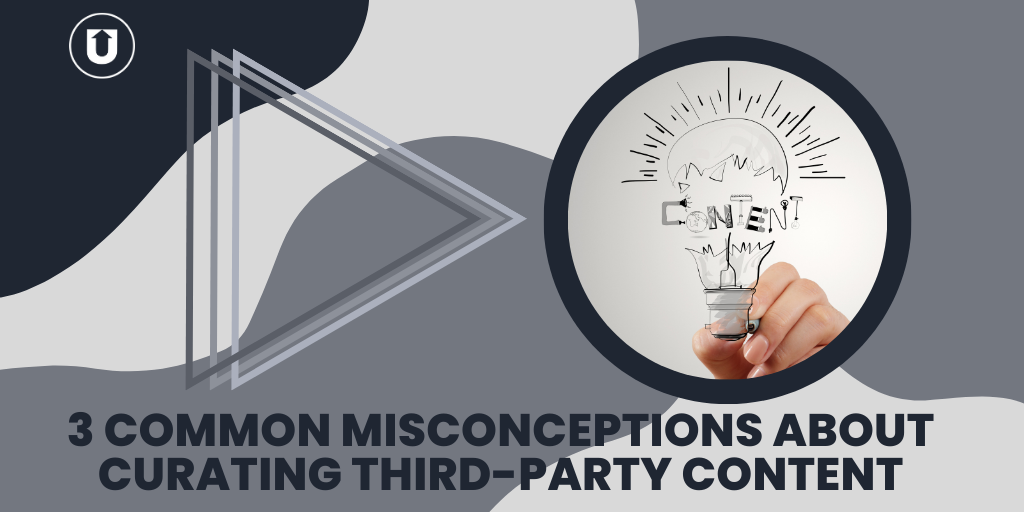3 Common Misconceptions About Curating Third-Party Content

Have you ever Googled or searched on TikTok what to talk about at a dinner party?
Me neither.
Anyway, we’ve all been to a dinner party at some point, and chances are, if you have had to come up with ideas of things to talk about, you have either had to sit beside someone who
- Had nothing interesting to say and just sat there in silence or
- They spent the whole night only talking about themselves.
Next time you wind up at a dinner party together, chances are you are NOT going to sit beside them, and you’ll tell your friends to avoid that fated seat as well.
But what if you sit down beside someone and you have an enjoyable conversation, and they say, “Oh, what you just said was interesting. I saw something recently along those same lines,” and they remember and send you the article the next day (or whenever).
This person went out of their way to show that they listened, remembered your conversation, and acted on it.
That differentiates them because they are leading with value - they're being helpful, trying to educate, and not pitching you on whatever they do for a living.
They established credibility and built trust with you through a conversation that would have otherwise been a boring dinner party.
So when you’re at the next dinner party, you’re definitely going to be encouraging your other friends to sit next to this person.
That sounds like a great way to build your network, right?
Now sub the dinner party for your digital profile, and that’s how building your thought leadership and credibility can go.
If you’re only ever talking about yourself, everyone will tune you out and avoid you, even if you are sharing great and valuable insights. Nobody likes someone who only talks about themselves - especially when they barely know them.
But suppose you are engaging in conversations, sharing ideas and thoughts from other sources, and adding your opinion and expertise when appropriate. In that case, you become that super cool dinner party guest that everyone wants to sit next to and somehow seamlessly joins in the discussion without taking it over.
As Jeff Bezos said, “We don’t make money by when we sell something. We make money when we help someone make a purchase decision.”
That’s where utilizing curated content can take your thought leadership and give it the credibility boost you need. However, despite its proven effectiveness, common misconceptions surrounding content curation can hinder its potential.
This blog post aims to debunk three prevalent misconceptions about curating content, shedding light on this essential practice's true power and benefits.
By addressing these misconceptions head-on, we hope to empower sales reps, marketers, thought leaders and content creators to fully leverage the potential of content curation and enhance their overall content strategy.
Misconception #1: Curated Content Cuts Off The Sales Cycle
This awful theory goes something like this.
If you keep a prospect in your sales funnel and send them all the information you want them to consider to make a buying decision, your sales cycle should be shorter by “owning the narrative.”
Keeping them away from any other options or competitors would take away the comparison and decision process and only give them more things to consider, right?
Not exactly, especially since the age of unlimited information at our fingertips.
In fact, isolating people with only your information and content will result in the opposite.
Your customers are smart - and only getting smarter- they will know that they have only heard from one perspective and then venture on their own to find external insights to support your claims - lengthening their sales cycle.
But using third-party content can shorten your sales cycle by providing your prospects with the external research they were already going to do.
Curated content won’t make it longer because at the end of that first call or before that first call, you can share a few articles you didn't write that you think they should read before speaking with you.
This helps them feel like they've checked that box of doing that research beforehand and that you are truly taking the role of helping them make the right decision for them rather than the right decision for you
You've made it an easier decision cycle because you helped them with their research process, but you weren’t telling them everything to believe or do.
You gave them the tools and power to decide for themselves.
This inspires confidence prior to the purchase and increases the likelihood they recommend your solution to others after the purchase because they are proud of the process they went through to select you!
Misconception #2: Lowers Online Engagement
Here at UpContent, we work with a lot of people in the marketing realm and many people in the sales realm, and their top concerns are slightly different for each.
We're accustomed to wanting to drive ALL traffic to the content we create in a direct line. So the concern is if you share an article written by somebody else, aren't you sending your audience to that location? Is that a waste?
Won’t curated content affect my bounce, engagement, and click-through rates, etc.?
And yes, it does, but in a positive way.
When we look at all of the research that's out there, not only does other people's content drive twice the engagement rate but if you're looking to give value to your audience, that mix of curated and original content is critical.
When you achieve the ideal content mix, somewhere around 50-75% of the content you share on social media linking to another domain helps the other 25-50% you share that links to your domain generate 10x the conversions.
Curated content will help you drive more conversions on a smaller number of original posts, and what you end up seeing is the engagement you’re gathering on the third-party content you’re sharing increases the size of your engaged audience.
So then, when you do introduce your own promotional or original post into that mix, you have a track record for building trust and giving value without asking for anything in return, prompting your audience will think, “Hmmm, they have been sharing some really great stuff, this looks like something they have created, I want to check it out.”
Even if the content you create, or the content your firm creates, is the best out there, it won’t have the same weight if that’s the only content you share because your audience wants context, and curated content provides context.
Misconception #3: You Can’t Build Thought Leadership If You Share Someone Else’s Content
We've seen a huge shift in the last few years where the brand is taking more of a supporting role, and the team member is stepping up and has to build their own brand as a thought leader.
People trust people, not brands.
But building thought leadership isn’t just you sharing a bunch of your thoughts without context, hoping people start listening to you.
Thought leadership requires credibility, and credibility is a culmination of your expertise paired with your authenticity to tell a clear story.
Credibility isn’t “just because you said so.”
Building your credibility can be done easily by sharing curated content created by other experts in your field in a thoughtful way, adding your opinion or reason for sharing that article.
That doesn’t have to take a ton of time, but the payoff is worth it.
Sharing articles from established sources breeds more authenticity and credibility than sharing only stuff from your brand or original content exclusively.
So now, instead of the brand being the credibility leader, the brand's role is to make sure that you have a number of those third-party articles at your fingertips, allowing them to easily select those that resonate with them and their audience.
Next Steps To Curating Third-Party Content
It's often said that people don't do business with a brand or a company. They do business with a person who represents that company - and this trend is only accelerating.
Mixing in curated content with your current digital strategy will help shorten your sales cycle, improve the quality of your online engagement, and build your credibility as a thought leader.
If you’re interested in learning more, download our free e-book, How To Drive Revenue Through Content-Without Writing It, or check out some of our other articles below!
More Curated Content = More Leads
How To Determine If Your Social Selling Strategy Is Successful



